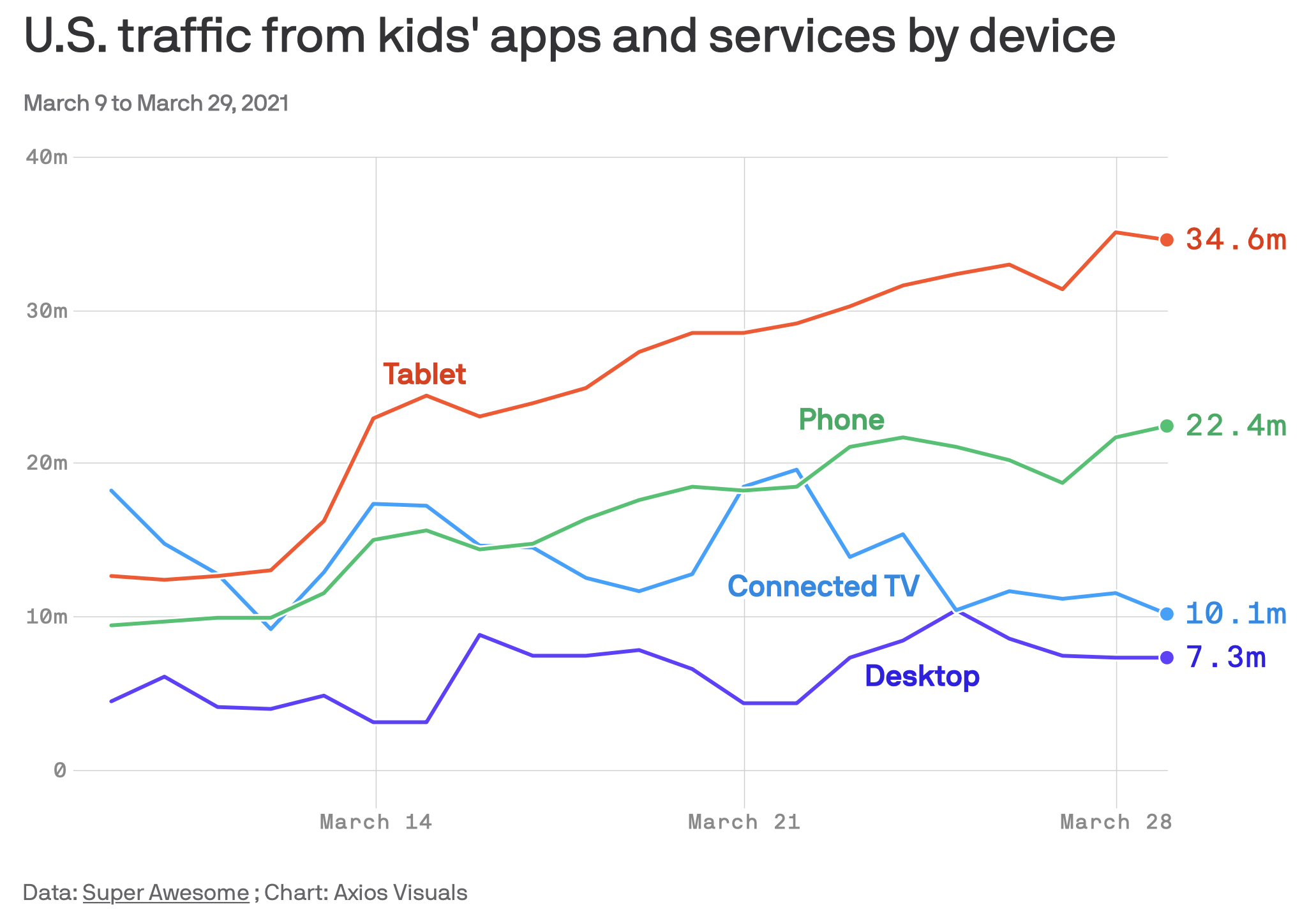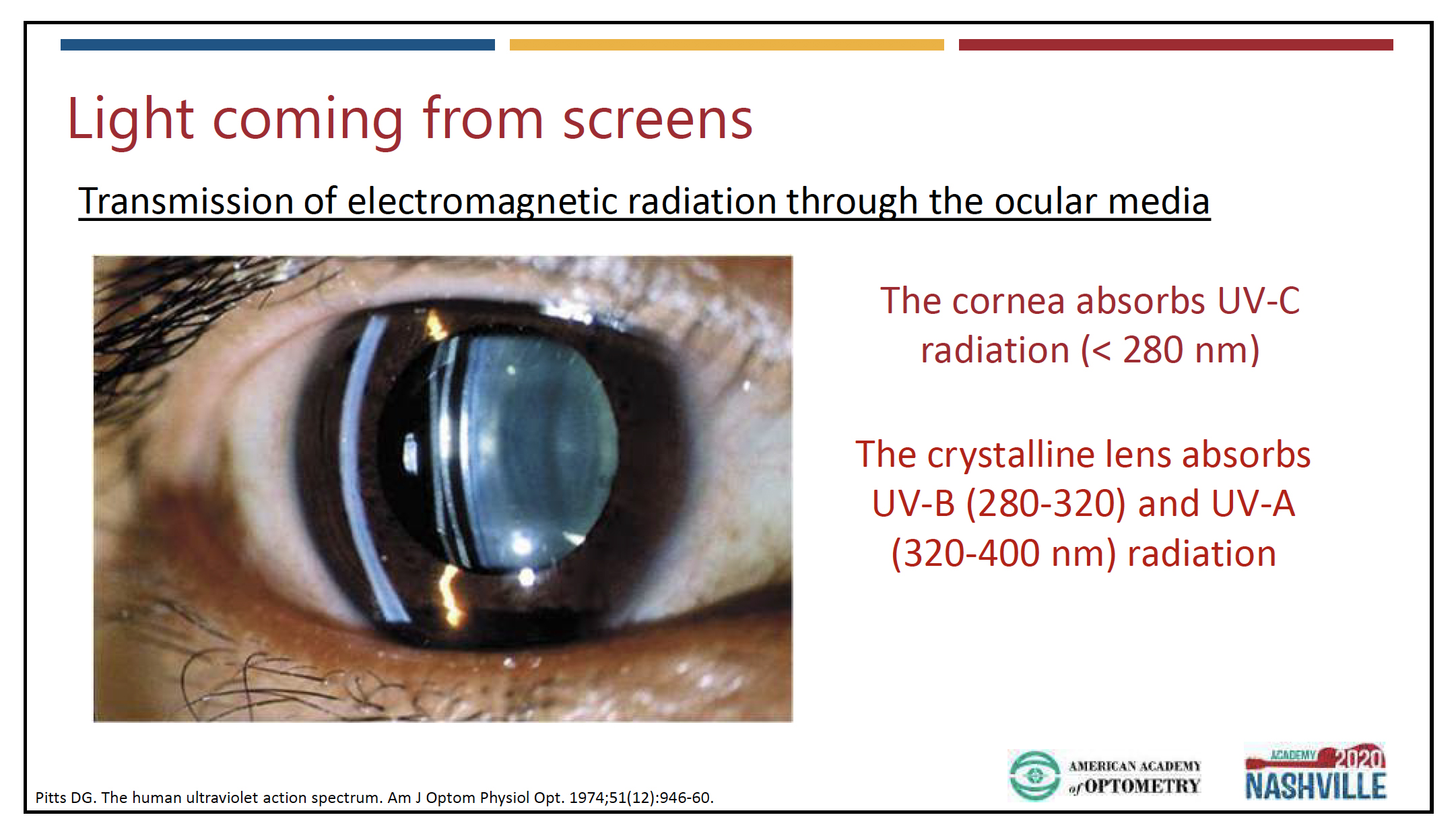We often read headlines telling us how terrible screens are for children, but there is little discussion about what these negative things really are. Attendees of Tuesday’s lecture, “Tots, Teens and Screens,” were able to learn a lot of background on the literature that has suggested that screen time can have negative implications in pediatric populations. Ann Morrison, OD, MS, FAAO, and Philip Yuhas, OD, PhD, FAAO talked about how to have better evidence-based discussions with their patients and their patients’ parents about the pros and cons of screen use in young people. They specifically highlighted the negative effects on physical, psychological and ocular health.
“The irony is not lost on me,” Dr. Morrison noted through the Academy’s virtual meeting interface. “We are giving a talk of implications of screen time at a point in time in history where we are tied to our screens so much more often due to the pandemic that COVID-19 has presented us.”
 |
| COVID-19 has driven teens and children to use their electronic devices more. In the first month alone, tablet use tripled and phone use doubled. |
“Even beyond our current conditions, we live in a world in which screens are everywhere,” she said. “Early on, we’ve had a lot of exposure and increase in availability of TVs and smartphones that we use on a daily basis, but this has moved to our work and day-to-day life.”
She noted that children are using screens, devices and computers for their learning experience, even prior to remote learning plans. However during this pandemic, COVID-19 has driven teens and children to use their electronic devices more. In these groups, Dr. Morrison noted that tablet use tripled and their phone use doubled.
True But Exaggerated
Dr. Yuhas then led the discussion on the effects of the light coming from screens.
When comparing the curves of the spectral profiles of mobile device and outdoor light, people are getting blue light exposure, but it is not much different in intensity from the blue light we get outdoors.
Dr. Yuhas then called attention to a study that determined that blue light would damage retinal pigment epithelium and photoreceptors was only limited to a lab setting. Another study that involved genetically modified cervical cells to act like photoreceptors found that blue light exposure causes apoptosis. However, the media misinterpreted the results and stated that blue light from phones and tablets could accelerate blindness and hurt vision.
“Don’t just read the headlines when you see these science stories—make sure you read the article,” he emphasizes. “Taking that conclusion from that study is an enormous stretch.”
Dr. Yuhas noted that the disconnect between work in the lab and the large epidemiologic studies in human subjects could be related to the protective elements of macular pigment and melanin in the retina that absorb high-energy blue light and act as an antioxidant.
While sunlight doesn’t cause macular degeneration, Dr. Yuhas said electronic devices likely don’t have an effect either. Using photopic lux as a proxy for brightness, he stated that an iPad with the brightness turned all the way up (325 lux) doesn’t compare to either light from a cloudy afternoon (1,000 lux) or a sunny day (100,000 lux) in terms of scale.
“When parents ask me whether the screens will damage their kids’ eyes from a retinal standpoint, the answer is no, it won’t,” he said.
Effects on Development
Dr. Morrison then detailed the physical and cognitive effects associated with increased screen time. Dr. Morrison also noted the effects screen time had on infants, as one study noted that for 18-month-old children who used a mobile media device, each additional 30-minute increase in daily mobile media device use was associated with an increased odds of parent-reported expressive speech delay. Still, 77.6% of parents reported zero minutes per day of mobile media usage in children.
A longitudinal study involving screen time and developmental milestones found that greater screen time at earlier milestones was associated with poorer performance on developmental screening tests at later milestones. “This could suggest that it is a causative effect, which we worry about,” Dr. Morrison said.
 |
| The constant barrage of light—both natural and artificial—taxes the ocular media, but the eye is well-equipped to withstand damage in most instances. |
When looking at children’s psychological well-being outside the classroom, a study found that the greater time spent on screens and mobile devices related to an increase in diagnosis of depression and anxiety in older teenagers (14- to 17-year-olds). While there was a lesser effect in 11- to 13-year olds, Dr. Morrison believes it is still enough to be warned of.
One study in Nature reviewing large datasets regarding adolescent well-being and digital technology found that the association they found between technology use and adolescent well-being is negative but small, explaining, at most, 0.4% of the variation. Dr. Morrison noted that studies that follow subjects over a long period time will help. “There’s a lot that we don’t know and there’s a lot to find out,” she said.
Vision and Sleep Problems
“Dr. Yuhas has made us feel better that screens aren’t causing retinal damage and macular degeneration, but what about other problems?” Dr. Morrison asked. While there is substantial evidence to support an association of myopia with near work, she noted that it is difficult to state that it is causative. While there is significant evidence that time outdoors is protective of developing myopia, there should also be concern regarding whether children are still spending more time on screens.
When patients complain of ocular and visual symptoms, Dr. Morrison emphasized a comprehensive examination that considers ocular health, refractive error and binocular vision. “Being on a computer exacerbates these dry eye-like symptoms, and also because of how much less people are blinking,” she noted. She highlighted cycloplegic refraction as well as an in-depth assessment of vergence, accommodation and saccadic function either in-office or referral.
Recommendations for Children and Screen TimeFrom the World Health Organization:
From the American Academy of Pediatrics
|
Dr. Yuhas then provided his thoughts on screen time and sleep disruption. He noted that all visible light, not just blue light, could drive ganglion cell signaling. Regarding smart phone use in the dark suppressing melatonin production, studies theorized that close working distance, screen brightness and room illumination enhance the effect. One study comparing people reading physical books with those with eBook devices revealed that those who read an eBook in the hours before bedtime had lower amounts of brain activity during the day.
Dr. Yuhas noted that using devices before bedtime does have a negative effect not only in young adults but also in children. While increasing television exposure leads to a reduction in sleep duration, reducing it lead to sleep recovery and longer sleep duration.
Spectacles vs. Filters
Dr. Yuhas noted that anti-reflective coatings had no effect on blocking blue light. While blue-blocking lenses improved subjective sleep quality and lengthened objective sleep duration, compared with clear lenses, Dr. Yuhas noted recent meta-analyses revealed that blue-blocking coatings and tints did not reduce digital eyestrain or enhance contrast sensitivity. “Cutting out blue light from the visual spectrum does nothing special to make computer use more comfortable,” he stated.
However, using the nighttime filters on phones and computers does make a difference. Studies determined that screen filters not only block more blue light than blue-blocking spectacles but also reduce overall illuminance. The screen filters were also associated with lower melatonin suppression values. Dr. Yuhas also noted that rigorous clinical studies still need to confirm the benefits of screen filters. “It’s not about blocking blue light alone, it’s about diming the screen down,” he emphasized.
Final Recommendations
Dr. Morrison wrapped up the lecture with recommendations from the American Academy of Pediatrics and World Health Organization that highlighted no sedentary screen time for children younger than two years old. They also stressed parental involvement when it comes to screen time, actively engaging and interacting with their children about the media they use. Dr. Morrison mentioned that tech-free bedrooms will prevent screen time implications on sleep, especially charging devices outside the bedroom. Since kids will use their screens more often to learn and socialize during the pandemic, Dr. Morrison emphasizes the preservation of offline experiences by parents.
“They know what limits are needed for their child, and aiming to find good quality content for them is super helpful,” she said. “Just urge parents to be involved as much as they can be to represent good behaviors.
For digital eyestrain patients, Dr. Morrison recommends averting eyes, following the 20-20-20 rule and spending time outdoors. “We hope you’ve gotten good information that makes you think a little differently and give good recommendations for you patients,” she concluded.
